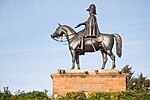Bourley and Long Valley
Sites of Special Scientific Interest in HampshireSpecial Protection Areas in England

Bourley and Long Valley is a 823.5-hectare (2,035-acre) biological Site of Special Scientific Interest between Fleet and Aldershot in Hampshire. It is part of Thames Basin Heaths Special Protection Area for the conservation of wild birds.This site has varied habitats, with heath, woodland, scrub, mire and grassland. The heathland is important for three vulnerable birds, woodlarks, nightjars and Dartford warblers. There is a rich invertebrate fauna, including the nationally scarce Eumenes coarctatus potter wasp, silver-studded blue butterfly and downy emerald dragonfly.
Excerpt from the Wikipedia article Bourley and Long Valley (License: CC BY-SA 3.0, Authors, Images).Bourley and Long Valley
Bourley Road, Hart Ewshot
Geographical coordinates (GPS) Address Nearby Places Show on map
Geographical coordinates (GPS)
| Latitude | Longitude |
|---|---|
| N 51.255 ° | E -0.806 ° |
Address
Bourley Road
GU52 8AD Hart, Ewshot
England, United Kingdom
Open on Google Maps







